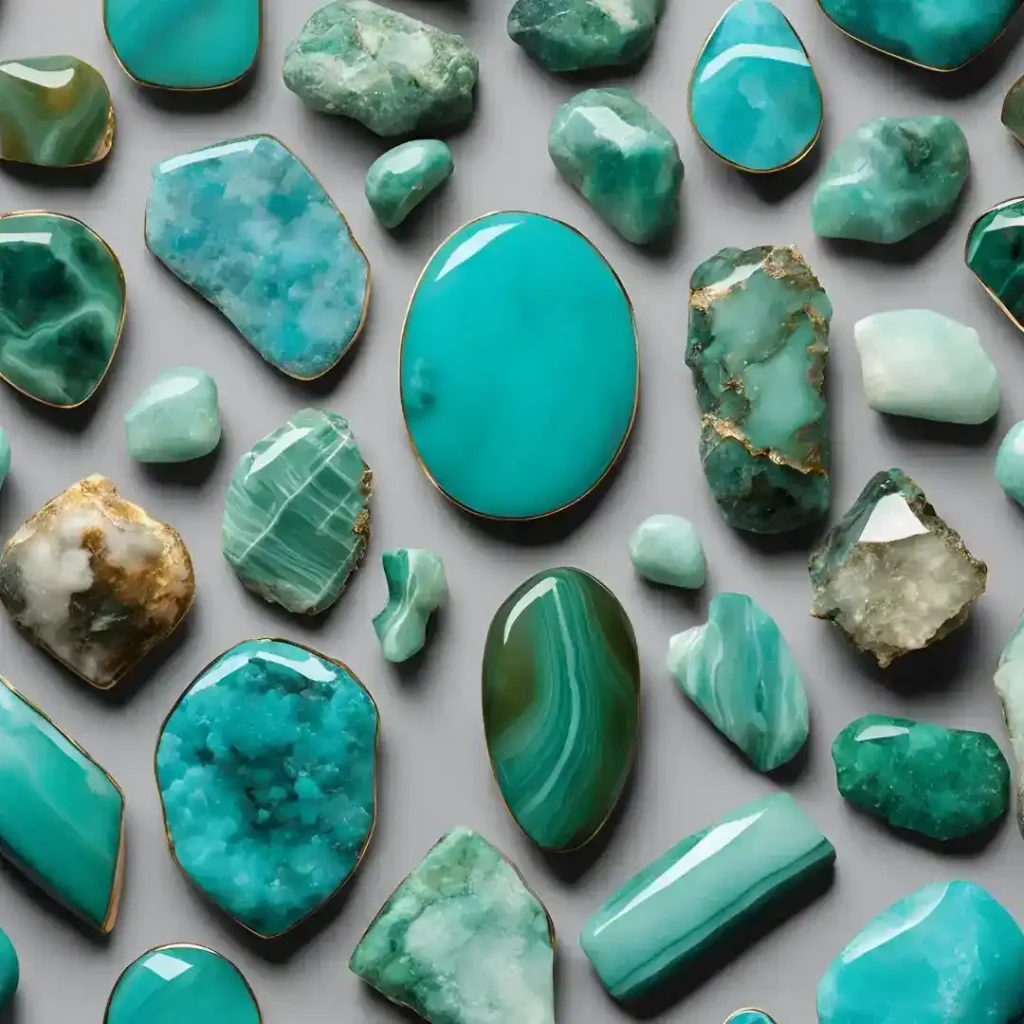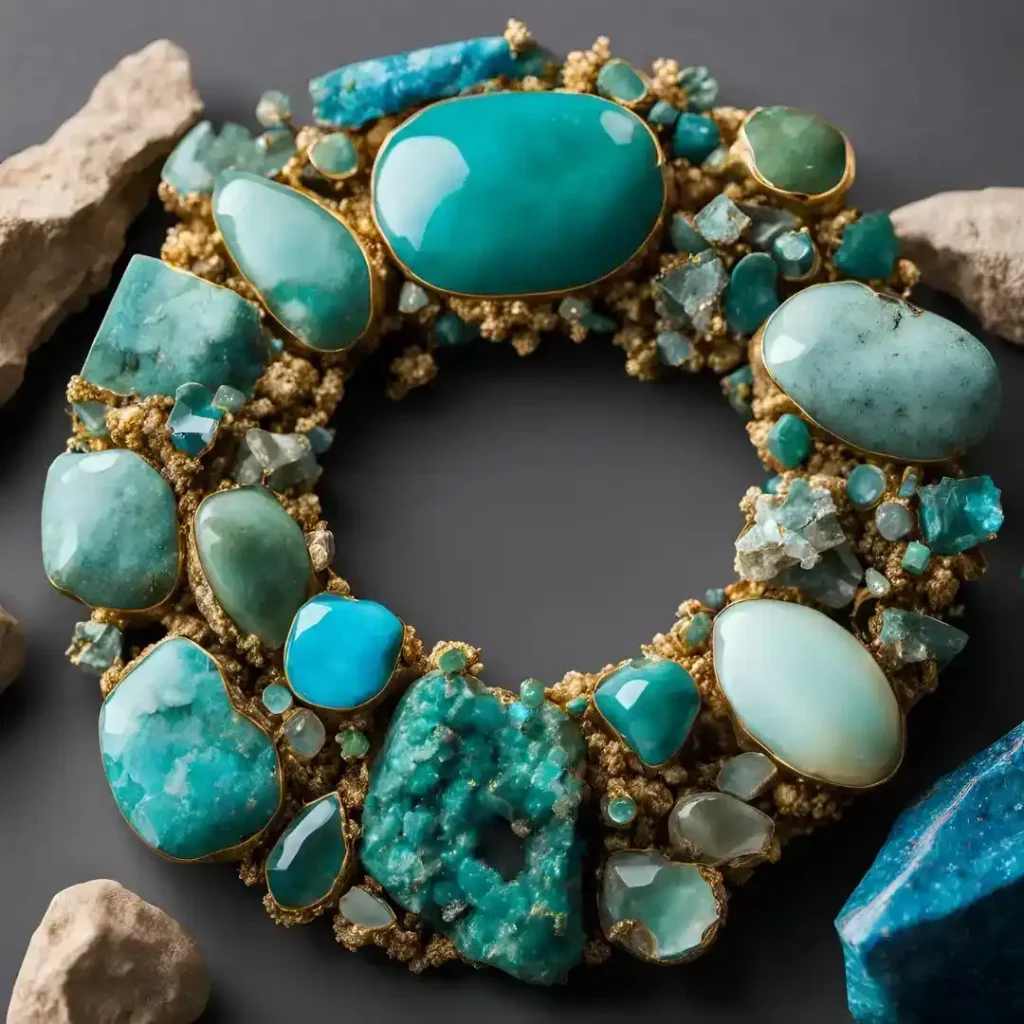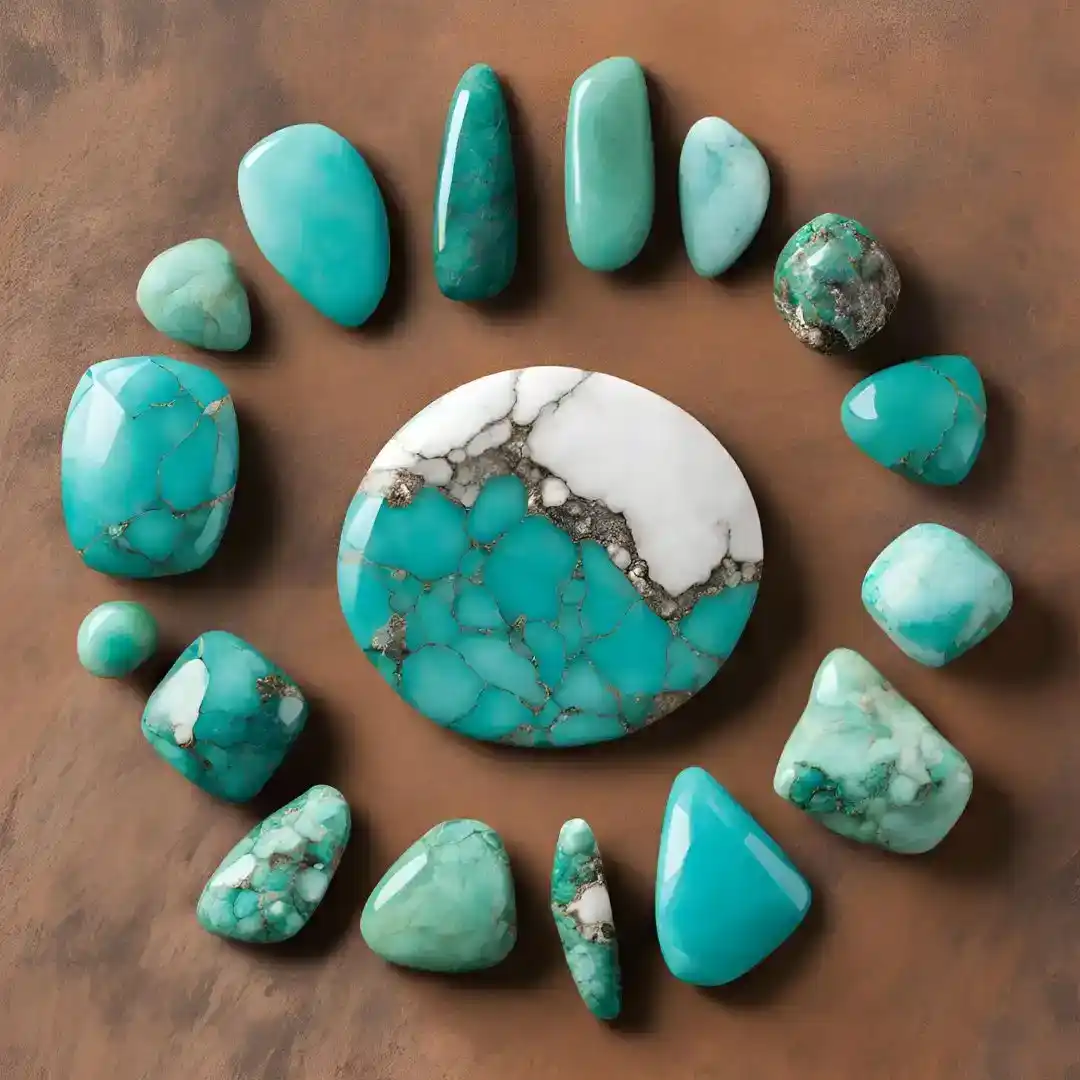When exploring the world of natural stones that look like Turquoise, one can’t help but be captivated by their unique beauty and diversity.
Turquoise, renowned for its prized blue-green colors and intricate matrix patterns, has been a gemstone favorite for centuries.
Yet, not all stones that catch our eye with turquoise-like allure are the genuine article.
There exists an array of minerals that are convincing doppelgangers, presenting themselves as visually similar to turquoise.
These include variscite, chrysocolla, magnesite, and howlite, each offering an enchanting display of hues and textures that can easily be mistaken for the high quality of natural turquoise.
The charm of these stones is not solely in their affordable cost; they possess their own distinct properties, compositions, and origins that set them apart from real turquoise.
To the expert eye, the differences in hardness, density, and other diagnostic properties are clear indicators of their true nature.
Despite not sharing the prestige and value of natural turquoise, these imposters are widely appreciated and preserved for their own unique qualities.
When purchasing these stones, discerning buyers must be skilled at identifying potential fakes or synthetics.
True turquoise has unmistakable characteristics like color variation, veining patterns, and surface texture. Knowing these clues helps in recognizing the authenticity of the stone.
With proper care and knowledge, the incomparable beauty of green stone that looks like Turquoise can be thoroughly appreciated and preserved, continuing to inspire and enchant.
Also Read: Who Should Not Wear Turquoise Stone: The Surprising Truth Revealed!
Are There Stones That Look Like Turquoise?
In the quest for gemstones with the allure of turquoise, spiritualists and enthusiasts often turn to natural materials that mimic the blue-green hues of this iconic stone.
Malachite, for instance, stands out with its vibrant colors and is valued not just for its appearance but also for its healing properties.
Its use in energy healing is well-known, believed to facilitate deep emotional release and nurture a connection with Mother Earth.
This stone helps individuals understand energetic boundaries and deepens intuitive insight, offering a unique energy that is both powerful and transformative.
The special vibration these stones carry can shift one’s perspective, aiding in personal growth and healing.
They present an opportunity to learn and change, to seek and enhance various aspects of our lives.
Whether used in meditation or as part of daily wear, stones like malachite provide more than just a visual resemblance to turquoise; they bring a whole new dimension of spiritual and emotional wellness.
Also Read: 15 Best Crystal Combinations For Sunstone For Peace and Prosperity

11 Stones That Look Like Turquoise But They Are Not
In the diverse world of gemstones, there are 11 stones that are visually similar to Turquoise but distinctly not.
Each boasts its own characteristics and qualities, making them distinct in properties and sources.
These gemstones offer a difference in beauty and essence, providing alternatives to those who admire Turquoise’s allure.
1. Howlite
Howlite is a fascinating mineral known to imitate Turquoise. It’s naturally white or colorless, with gray or black veins. Its porous nature is perfect for dyeing, achieving a stunning blue hue.
Though it lacks the durability and rarity of genuine Turquoise, howlite is both affordable and accessible, making it a favorite among jewelry designers like Laura, who crafts beautiful pieces without breaking the bank.
Also Read: Why Cant Carnelian And Amethyst Be Together
2. Variscite
Variscite, often termed the green cousin of Turquoise, is a lesser-known gemstone. It ranges from light to dark green, with blue undertones and a captivating web-like pattern.
An enthusiastic collector, Jack, discovered its unique charm at a gem show, initially convinced it was Turquoise until a closer inspection revealed its true nature. It has since become a prized addition to his collection.
3. Amazonite
Amazonite, a member of the feldspar family, captivates with its vibrant blue to deep teal hues, often interlaced with white streaks adding to its visual intrigue.
Sophia, a young woman with a deep affinity for energy and aesthetic, incorporates amazonite into her wardrobe, finding it resonates with her more than turquoise.
Its soothing and calming properties offer not just a pleasing appearance but also beneficial energy for her daily life.
4. Magnesite
Magnesite, a versatile mineral, comes in a variety of colors including white, gray, brown, and blue.
Often dyed to mimic turquoise, it serves as an affordable substitute for jewelry designers like Tom, who seeks budget-friendly alternatives.
His designs using magnesite evoke the beauty of turquoise but without the hefty price tag, showcasing the versatility and affordability of this lookalike stone.
Also Read: Lapis Lazuli Negative Effects
5. Chrysocolla
Chrysocolla is a truly mesmerizing gemstone, boasting a breathtaking blend of blue and green hues.
Found often in copper deposits, its remarkable similarity to turquoise makes it a sought-after alternative.
Beyond its visual appeal, chrysocolla is revered for its metaphysical properties, known as the Stone of Communication. It’s said to encourage self-expression, clarity, and emotional balance.
For Isabella, drawn to the color and in search of a deeper connection to her spiritual journey, chrysocolla has become a significant part of her personal growth.
6. Chalcopyrite
Chalcopyrite, often dazzling as Peacock Ore, is a common ore mineral that is frequently mistaken for turquoise due to its vibrant array of colors.
Beyond its striking shades of brassy-golden hue, which contrast sharply with genuine turquoise, it offers notable benefits.
This versatile copper iron sulfide compound is known for its strong power to remove energy blockages and activate both the chakras and the mind.
When polished and cut, Chalcopyrite transforms into gemstones with an opalescent effect, making it visually appealing, yet not quite qualifying as a true turquoise.

7. Faience
Faience, a unique material made from quartz and sand, presents an interesting case.
It often sports a base color that can mimic the look of more precious stones like turquoise.
While it may lack the intrinsic value and rarity of turquoise, its attractiveness makes it worth considering.
Known for centuries as an affordable alternative to semi-precious stones, Faience has been appearing in jewelry and art forms, achieving an aesthetic without the associated expense.
8. Glassy Malachite
Glassy Malachite is another stone often mistaken for turquoise. It boasts vibrant green and blue colors, similar to its natural gemstone cousin, turquoise.
Upon inspection, its flecks of copper give it a distinct lustre, setting it apart. Though harder than turquoise, it has a soft and subtle texture, making it ideal for crafting jewelry.
Glassy Malachite is also known for its ability to encourage taking risks and stepping forward in new projects, and it’s believed to boost the immune system.
Its unusual shapes make it an interesting choice for craftsmen and artisans, as no two stones are exactly alike.
Also Read: Rose Quartz Breaking Meaning
9. Blue Apatite
Blue Apatite is a stone with characteristic white to light brown veins, offering a distinct alternative to the beauty of turquoise.
Known for its properties in healing emotional trauma and relieving stress and anger issues, it’s perfect for jewelry applications.
Often combined with other minerals like jasper, it forms striking pieces that captivate the eye.
10. Nephrite
Nephrite is a type of stone often mistaken for turquoise due to its distinctive appearance of a bright and luminous green hue.
Unlike turquoise, it features fine fibers on its surface, a feature absent in turquoise.
With a higher density and feeling heavier to the touch, Nephrite stands as an exquisite and attractive substitute.
It’s known for bringing inner peace and balance, especially in bad situations, and for attracting positive energies.
11. Variscite
Variscite, an often overlooked gemstone, shares a similar appearance to turquoise.
Unlike its famous cousin, it forms into dense nodules rather than vein-like structures.
Less well-known in art forms, its soft color and interesting pattern make it desirable.
Known for its grounding and wealth properties, Variscite provides clarity, wisdom, and intelligence, and is great to relieve anxiety.
For those with a discerning eye, it’s a gorgeous substitution without breaking the bank.
Also Read: What Does Green Mean On A Mood Ring
How To Know If It’s A Real Turquoise Stone?
In a market teeming with turquoise imitations and replicas, distinguishing a real from a fake piece can be quite the task.
When purchasing a genuine stone, knowing the markers of an authentic turquoise is key.
1. Check For A Certificate Of Authenticity
Always seek a Certificate of Authenticity when purchasing genuine turquoise.
This official document serves as both proof of origin and quality assurance, issued by trained professionals who are qualified to recognize ethically sourced turquoise.
2. Research The Supplier
Thoroughly researching the supplier before purchase is essential. Ensure they have a proven track record for providing genuine turquoise stones.
Trustworthy sources often have positive reviews from past customers and are willing to provide references to validate their quality and service.
3. Check The Quality Of The Stone
Inspect the quality of the turquoise stone carefully. Genuine turquoise should have an even, consistent color, free from cracks, chips, or abrasions.
Any discoloration or structural inconsistencies can be a sign of a fake.
4. Know How To Spot Fake Turquoise
To spot fake turquoise, be alert to characteristics like discoloration, artificial staining, or glossy surfaces. A magnifying glass can help inspect for irregularities.
Be wary of any stones that are too large at a given price point, as this could indicate they’ve been artificially inflated.
5. Ask An Expert
If still unsure, consult an expert in turquoise jewelry. An expert’s opinion can help determine if your stone is genuine, especially if it comes from a reputable source and exhibits high quality.
They’ll assess its authenticity, giving you a better chance of ensuring your purchase is the real deal.
Also Read: 9 Side Effects Of Moonstone Revealed
FAQs About Blue Stone That Looks Like Turquoise
1. What Stone Looks Like Turquoise But Isn’t?
Common substitutes for genuine Turquoise include Howlite and Magnesite. These stones are often used due to their similar appearance but differ in their natural composition and properties.
2. What Is A Stone Similar To Turquoise?
Chrysocolla is a gemstone often confused with turquoise. It shares a similar color palette but has distinct mineral characteristics that set it apart.
3. What Is The Blue Stone That Looks Like Turquoise?
Shattuckite, a unique copper silicate mineral, was first discovered in the Shattuck Mine in Bisbee, Arizona. It exhibits colors similar to turquoise and often pseudomorphs after malachite, but it rarely grows in large crystal form.
4. What Stone Is Dyed To Look Like Turquoise?
Often, fake Turquoise is actually howlite, a gray and white stone with dark gray veins. It is commonly dyed blue to mimic the appearance of turquoise.
5. How Can I Tell Real Turquoise From Fake?
Fakes are typically made from dyed howlite, magnesite, or cheap plastic. Authentic turquoise is an opaque stone, typically in robin’s egg blue or greenish blue. If it appears transparent or in colors like white, red, or purple, it’s probably fake and may scratch easily.
6. Can These Alternatives Be Used In Place Of Turquoise In Jewelry?
Yes, these alternatives are affordable and versatile for jewelry designs. They share the vibrant hues and intricate veining of turquoise, making them perfect for various jewelry styles.
7. Are These Turquoise Substitutes Valuable?
While not as valuable as genuine turquoise, these substitutes have their own unique properties and appeal. They are appreciated for their affordability and diversity by collectors and jewelry enthusiasts.
8. How Can I Care For My Turquoise Lookalike Jewelry?
Caring for your turquoise lookalike jewelry involves practices similar to those for genuine turquoise. Avoid exposing it to harsh chemicals, perfumes, or excessive moisture. Clean it with a soft cloth and mild soapy water, and then pat dry gently.

Final Thoughts
In conclusion, the world of stones that look like Turquoise offers a captivating array of alternatives that are not only aesthetically pleasing but also carry their own unique charm and history.
From the versatile howlite to the green-hued variscite, the soothing amazonite, and the budget-friendly magnesite, each of these stones serves as a testament to the rich diversity within the realm of gemstones.
The spiritually charged chrysocolla and other such alternatives hold a special place in the hearts of collectors and jewelry designers, offering a classic aesthetic that resonates deeply with those who love the captivating blue hues of traditional turquoise.
These doppelgangers not only delight and inspire but also cater to those yearning for a piece of the earth’s beauty.
In essence, exploring these turquoise alternatives is like uncovering hidden treasures—each stone with its own story, adding to the tapestry of one’s personal style and journey.
